
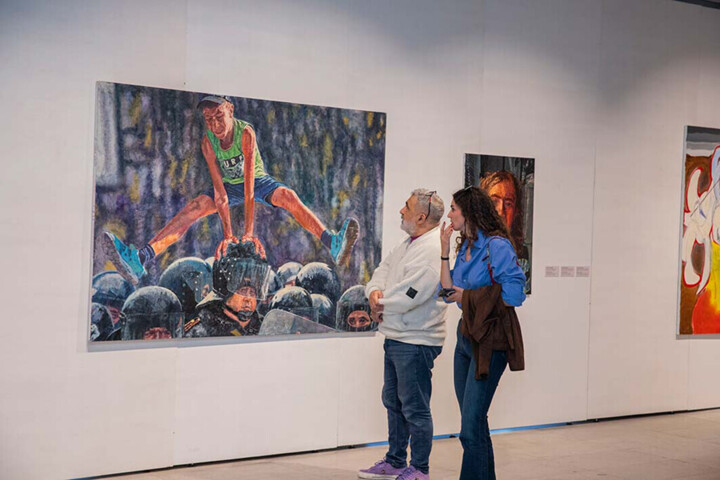
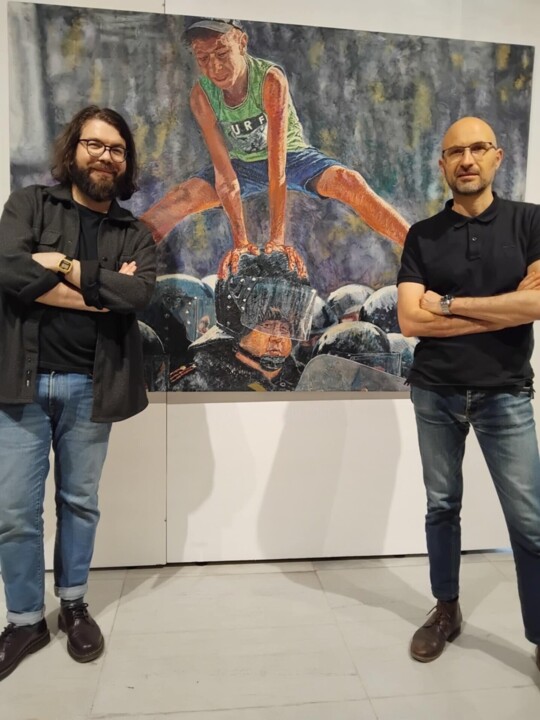
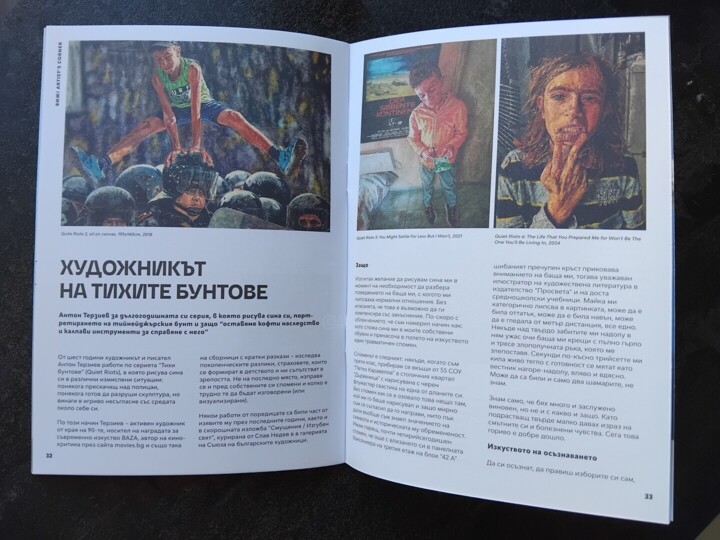
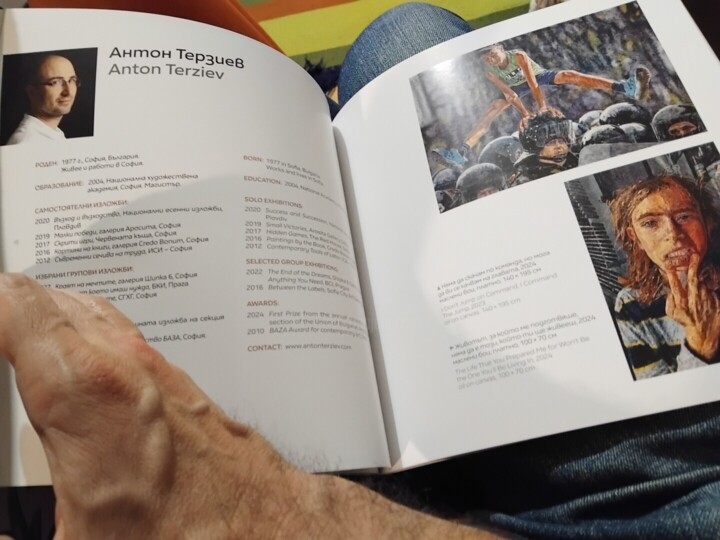

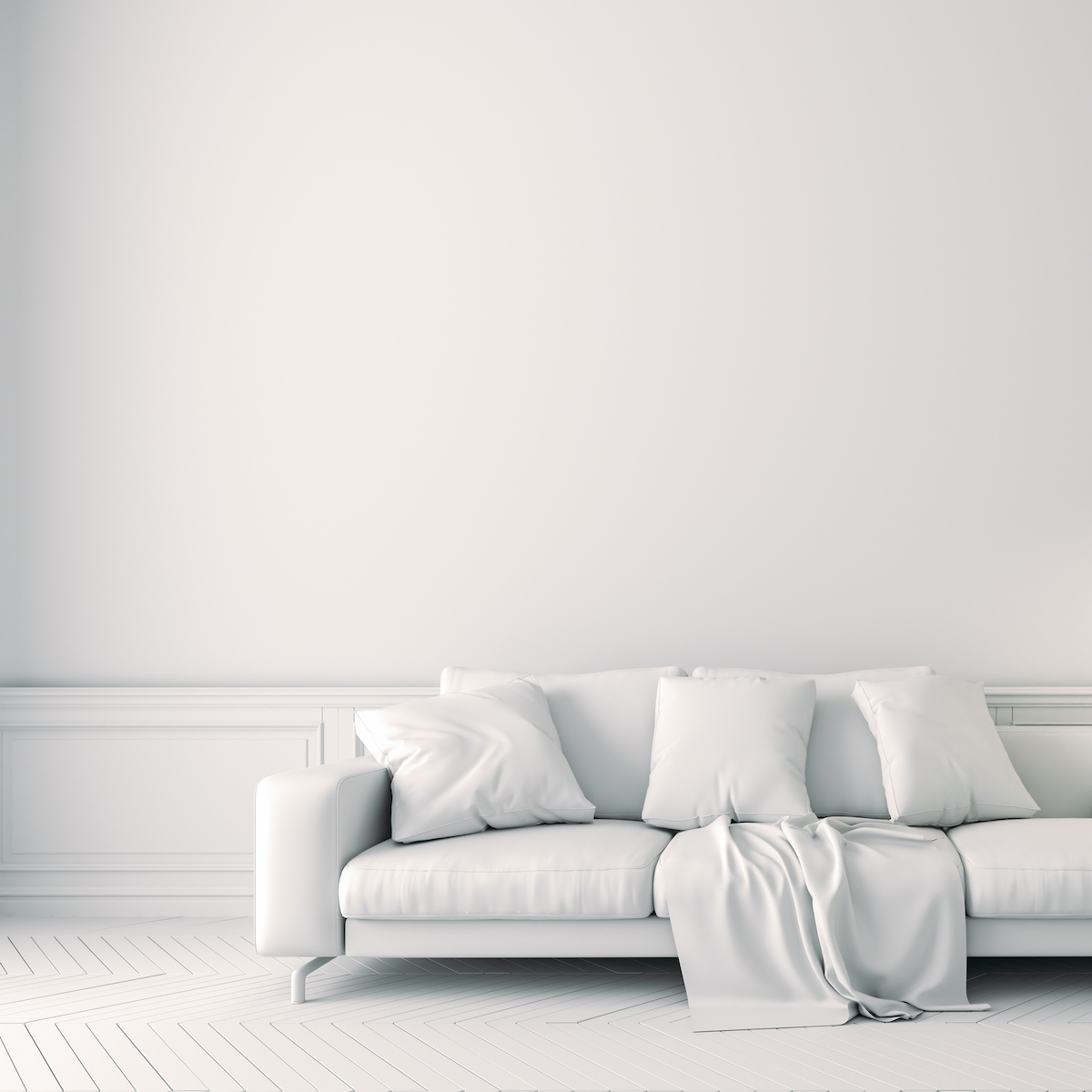
이 작품의 사진을 더 보고 싶다면 알려주세요!
- 작품의 뒷면 / 작업의 측면
- 세부사항 / 서명 / 작품의 표면이나 질감
- 상황에 맞는 작품, 다른...
I Don't Jump On Command, I Command The Jump (2025) 미술작품 Anton Terziev 로
상세 정보
- 포장 (상자 또는 판지 포장) 모든 작품은 세심하게 보호되고 보험에 가입된 프리미엄 캐리어와 함께 배송됩니다.
- 트레킹 소포가 구매자에게 배달될 때까지 주문 추적. 실시간으로 소포를 추적할 수 있도록 추적 번호가 제공됩니다.
- 지연 3~7일 이내에 전 세계 배송 (추정)
- 관세는 포함되지 않습니다. 가격은 관세를 포함하지 않습니다. 대부분의 국가에서는 원본 작품에 대해 수입세가 없지만 감면된 VAT를 지불해야 할 수도 있습니다. 세관 수수료(있는 경우)는 도착 시 세관에서 계산해야 하며 운송업체에서 별도로 청구합니다.
상세 정보
- 추적 가능한 온라인 정품 인증서 진품 인증서는 작품 코드를 스캔하여 언제든지 온라인으로 확인할 수 있습니다.
- 아티스트 가치 인증 전문가는 예술가의 작업과 경력을 연구하고 독립적이고 신뢰할 수있는 평균 가격 값을 설정합니다. 평균 가격 가치는 예술가를 주어진 기간 동안 가격대에 위치시킵니다. 전문가는 특정 작업에 대해 보다 정확한 추정치를 설정하도록 요청할 수도 있습니다.
상세 정보
SSL 인증서를 사용하여 100 % 안전 지불 + 3D Secure.
상세 정보
귀하의 웹 사이트, 커뮤니케이션에 이 이미지를 사용하거나 파생 제품을 판매하려면 라이센스를 구입하십시오.
Usage: 웹 라이선스
| 1500 px | ||

|
1030 px |
| 파일의 크기 (px) | 1500x1030 |
| 전 세계적으로 사용 | 네 |
| 다중 지원에 사용 | 네 |
| 모든 유형의 미디어에 사용 | 네 |
| 재판매 권리 | 아니오 |
| 최대 인쇄 매수 | 0 (Zero) |
| 판매용 제품 | 아니오 |
구매 즉시 다운로드
이 이미지는 라이선스로 다운로드할 수 있습니다.: 언제든지 다운로드할 수 있습니다.
제한
ArtMajeur의 모든 이미지는 아티스트가 만든 원본 예술 작품이며 모든 권리는 엄격하게 보유됩니다. 라이선스를 취득하면 라이선스 조건에 따라 이미지를 사용하거나 활용할 수 있는 권한이 부여됩니다. 프로젝트에 완벽하게 맞도록 이미지를 재구성하거나 초점을 다시 맞추는 등 사소한 수정은 가능하지만 사전에 아티스트의 서면 승인을 얻지 않는 한 원본 작품의 무결성을 손상시킬 수 있는 수정은 금지됩니다(모양 수정, 왜곡, 절단, 색상 변경, 요소 추가 등 ...).
커스텀 라이선스
귀하의 사용이 당사의 표준 라이선스에 포함되지 않는 경우 당사에 연락하여 맞춤형 라이선스를 요청하십시오.
아트 이미지 뱅크-
원작 (One Of A Kind)
미술작품,
캔버스의
기름
- 치수 높이 57.1in, 폭 76.8in
- 프레이밍 이 작품은 액자가 없습니다
- 카테고리 회화 {가격} 이하 조형 미술 정치
The painting’s focal point is a youthful figure leaping over a heavily armored officer. The choice to place this figure mid-action—hands pressing atop the helmet—lends the painting a kinetic energy. Terziev halts a fleeting instant, reminiscent of photojournalistic “freeze-frames,” yet renders it in a painterly style. This tension between photo-like immediacy and the expressiveness of oil paint gives the scene both documentary clarity and a certain timelessness.
The tight framing around the main subjects emphasizes the confrontation. In the background, a phalanx of similarly clad officers recedes into an indistinct crowd, hinting at a broader social or political apparatus. The dynamic pose of the young figure—legs extended, arms bearing weight—cuts diagonally across the canvas, drawing the viewer’s eye from the figure’s face to the helmet below. This diagonal thrust is a compositional technique often employed to heighten drama, recalling, for instance, the angled bodies in Eugène Delacroix’s “Liberty Leading the People.” Terziev appears to favor a saturated palette: the vivid greens of the protester’s shirt and the deep blacks of the riot gear contrast sharply. The background’s muddled, smoky hues evoke tension and turmoil. Despite this gloom, the central figure seems illuminated—whether literally or symbolically—standing out against the massed uniforms. This painterly contrast underscores a classic artistic trope: the individual’s bright presence opposing a darker, more uniform collective force.
At first glance, the painting comments on the power dynamic between state authority (the officer in riot gear) and the individual (the agile figure vaulting over him). The act of physically leaping above the officer’s head becomes a metaphor for transcending imposed limits or commands. It suggests a reversal of typical power structures: the officer, usually the figure of control, is relegated to a support—albeit involuntarily.
The subject’s youthful appearance adds another layer of resonance. Depicting a young individual in direct, physical interaction with law enforcement draws upon an established tradition of protest imagery, where youth movements have historically galvanized political change. This generational tension recalls iconic photographs from the 20th and 21st centuries, in which young protesters often become the faces of revolution or societal critique.
The painting also alludes to the idea of the human body as a site of protest. The choice to vault, rather than to push or to attack, speaks to a form of resistance that is acrobatic, creative, and emblematic of personal freedom. It contrasts with the rigid, disciplined body language of the officers. In this sense, the work resonates with a lineage of politically charged performance art and photography, wherein gestures of dance or athleticism become statements of defiance.
While Terziev’s style is distinct from the Romantic or Baroque, the thematic of state power versus individual vulnerability recalls Francisco Goya’s **“The Third of May 1808.”** There, too, we see a focus on the human cost of political strife. Goya’s unflinching look at violence resonates in Terziev’s more contemporary depiction of confrontation, even if the latter is less about overt bloodshed and more about tension and symbolic subversion.
More directly, the painting aligns with 20th- and 21st-century traditions of politically engaged art—think of works by artists such as Banksy or Ai Weiwei, who fuse bold imagery with pointed social critique. Terziev’s piece, however, remains firmly in the realm of painting, bringing to mind large-scale compositions that historically served as calls to action or documentation of collective struggle.
Although the painting captures a realistic moment, the brushwork seems deliberately visible—especially in the musculature of the figure and the textured rendering of the riot gear. This blend of realism and expressionistic brush handling imparts an emotive quality. The painting avoids the polished sheen of hyperrealism, instead embracing a slightly raw surface that mirrors the rawness of civil strife.
As a large-scale work, the painting presumably envelops the viewer, magnifying the tension between protester and authority. Large canvases historically lend a monumental aura to their subject matter—an effect that can transform a single leap into a sweeping allegory of societal power struggles.
I Don’t Jump On Command, I Command the Jump” stands as a compelling example of contemporary political painting. Through a vividly captured, acrobatic gesture of defiance, Anton Terziev provokes reflection on youth, power, and the state’s response to public dissent. The painting’s dynamic composition, saturated color contrasts, and expressive brushwork imbue it with a timeless urgency. In art historical terms, it joins a lineage of works that memorialize moments of societal upheaval—echoing both the immediacy of photojournalism and the grandeur of historical painting.
By framing the tension between the individual and the forces of authority in a single, frozen leap, Terziev not only documents a poignant political instant but also suggests the broader, universal spirit of protest that transcends geographic and temporal boundaries. The painting thus resonates as a contemporary emblem of resilience—both a snapshot of a specific socio-political climate and a more enduring symbol of the human impulse to rise above constraints.
관련 테마
현대 불가리아 예술가인 안톤 테르지예프(Anton Terziev)는 날카로운 아이러니를 예술적 도구로 사용하여 다양한 현대 주제를 다루는 데 능숙합니다. 그의 작품은 냉혹하고 비판적인 이미지를 전달하는 도상학을 심오하게 사용하는 것이 특징입니다. 그의 예술적 레퍼토리에서 Anton은 스테이크, 기술 및 스토리텔링 요소를 능숙하게 결합하여 사회적 논평, 유머 및 예술가의 상태에 대한 메시지를 섬세하게 전달하는 비유적인 현대 미술을 탄생시켰습니다.
Anton Terziev는 서로 다른 두 가지 소스에서 영감을 얻습니다. 첫째, 그의 예술은 종종 실제 사건에서 탄생하여 그의 창작 과정을 촉발하는 방식으로 그의 주변에서 펼쳐집니다. 둘째, 그의 상상력은 그의 작품에서 중추적인 역할을 하여 생생하고 생각을 자극하는 이미지를 만들어낸다. 그의 작품 하나하나에는 영화와 책에서 추출한 대중문화의 미묘한 요소가 가미되어 있습니다. 모든 작품에는 시청자의 경험을 압도하지 않으면서 풍요롭게 하는 메타텍스트인 내러티브가 내재되어 있습니다. Anton은 좋은 예술이 부드럽지만 효과적으로 소통한다고 믿기 때문입니다.
Anton의 작업을 구별하는 것은 청중에게 무한한 경이로움을 선사하려는 그의 확고한 헌신입니다. 그의 작품은 관객이 예술과의 대화에 참여하도록 유도하여 그가 제시하는 내러티브를 해석하고, 질문하고, 탐색하도록 격려합니다. 자신의 작품에 딱 맞는 제목을 선택하는 일은 그가 문학, 영화, 음악에서 영감을 얻어 자주 해결하는 과제입니다.
화가로서의 Anton Terziev의 경력은 작가로서의 그의 정체성과 복잡하게 얽혀 있습니다. 그의 아이디어는 그의 다양한 재능을 반영하여 그림과 예술품의 형태로 구체화됩니다. 회화를 넘어 그는 공연, 영화 제작, 디자인을 통해 자신의 예술적 비전을 생생하게 표현하며 창의적인 표현에 대한 다각적인 접근 방식을 보여줍니다.
-
국적:
불가리아

- 생년월일 : 1977
- 예술적 영역: 전문 예술가들의 작품,
- 여러 떼: 전문 아티스트 현대 불가리아 예술가















